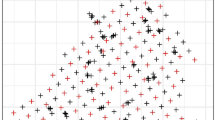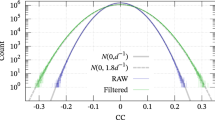Abstract
A modified k-nearest-neighbors method is introduced that provides an efficient nonlinear estimate of the intensity of a point process (field) based on locations of events. The method is applied to perform a detailed statistical analysis of the spatial structure of the seismic intensity field (in the context of this paper, the term “intensity” refers to the intensity of the seismic field, and should not be mistaken for the intensity of ground motion caused by an earthquake). The proposed method requires neither a preliminarily delineated area nor a normalization procedure for the estimates. In contrast to many interpolation methods, estimates based on the proposed method are statistically justified. The “uncertainty relation” between the spatial smoothing effect and random errors is established for the method in an explicit form. A procedure for choosing the number of nearest neighbors k* that controls the effective radius of smoothing is suggested. The proposed method is applied to analyze the seismic intensity field in two seismogenic regions surrounding the Kuril Islands and Japan during the period from 1904 to 2011. Spots of increased seismic activity in these regions are localized by the new method, and some quantitative statistical characteristics of these spots are determined and discussed.











Similar content being viewed by others
References
Cover, T. M., & Hart, P. E. (1967). Nearest neighbor pattern classification. IEEE Transactions on Information Theory, 13, 21–27.
Efron, B. (1979). Bootstrap methods: another look at the jackknife. The Annals of Statistics, 7(1), 1–26
International Seismological Centre (2017) Summary of Bulletins of Internatonal Seismological Centre, January-June 2014, 51(1), Thatcham, United Kingdom
Jackson, D., & Kagan, Y. (1999). Testable earthquake forecasts for 1999. Seismological Research Letters, 70(4), 393–404.
Kagan, Y. (2003). Accuracy of modern global earthquake catalogs. Physics of the Earth and Planetary Interiors, 135, 173–209.
Kagan, Y., & Jackson, D. (1994). Long-term probabilistic forecasting of earthquakes. Journal of Geophysical Research, 99(B7), 13685–13700.
Kagan, Y., & Jackson, D. (2000). Probabilistic forecasting of earthquakes. Geophysical Journal International, 143, 438–453.
Kendall, M. G., & Moran, P. A. P. (1963). Geometrical Probability, Griffin's Statistical Monographs and Courses, no. 5, C.Griffin, London.
Kitanidis, P. K. (1997). Introduction to Geostatistics. Cambridge University Press.
Loftsgaarden, D. O., & Quesenberry, C. P. (1965). A nonparametric estimate of a multivariate density function. The Annals of Mathematical Statistics, 36, 1049–1051.
Marekova, E. (2014). Analysis of the spacial distributions between successive earthquakes occurred in various regions in the word. Acta Geophysica, 62(6), 1262–1282.
Nas, M., Lyubushin, A., Softa, M., & Bayrak, Y. (2020). Comparative PGA-driven probabilistic seismic hazard assessment (PSHA) of Tukey with a Bayesian perspective. Journal of Seismology. https://doi.org/10.1007/s10950-020-09940-5.
Nekrasova, A. K., & Kossobokov, V. G. (2021). The unified scaling law for earthquakes. Journal of Volcanology and Seismology, 14, 353–372.
Ogata, Y., & Katsura, K. (1993). Analysis of temporal and spatial heterogeneity of magnitude frequency distribution inferred from earthquake catalogs. Geophysical Journal International, 113, 727–738.
Pisarenko, V. F., Geilikman, M. B., & Golubeva, T. V. (1990). Multifractal patterns of seismicity. Physics of the Earth and Planetary Interior, 99, 127–138.
Pisarenko, V. F., & Pisarenko, D. V. (1993). Spectral properties of multifractal measures. Physics Letters A, 153, 169–172.
Pisarenko, V. F., & Rodkin, M. V. (2015). The maximum earthquake in future T years: Checking by a real catalog. Chaos, Solitons & Fractals, 74, 89–98.
Pisarenko, V. F., & Rodkin, M. V. (2019). Declustering of seismicity flow: statistical analysis. Izvestiya, Physics of the Solid Earth, 55(5), 733–745.
Pisarenko, V. F., & Rodkin, M. V. (2020). Statistics and spatial-temporal structure of ground acceleration caused by earthquakes in the north-western pacific. Pure and Applied Geophysics, 177(6), 2563–2578.
Ripley, B. D. (1988). Statistical Inference for Spatial Processes. Cambridge University Press.
Schaback, R. (1995). Error estimates and condition numbers for radial basis function interpolation. Advances in Computational Mathematics, 3, 251–264.
Silverman, B. W. (1986). Density Estimation for Statistics and Data Analysis, Monographs on Statistics and Applied Probability. London: Chapman and Hall.
Stock, C., & Smith, E. G. C. (2002a). Adaptive kernel estimation and continuous probability representation of historical earthquake catalogs. Bulletin of the Seismological Society of America, 92(3), 904–912.
Stock, C., & Smith, E. G. C. (2002b). comparison of seismicity models generated by different kernel estimations. Bulletin of the Seismological Society of America, 92(3), 913–922.
Storchak, D. A., Bodnar, G. D., Engdahl, E. R., Harris, J., Lee, W. H. K., Villasenor, A., & Borman, P. (2013). Public release of the ISC-GEM global instrumental earthquake catalogue (1900-2009). Seismological Research Letters, 84(5), 810–815.
Ulomov, V. I. (2018). Seismic Zoning, EOLSS, Earth and Atmospheric Sciences. Natural Disasters, 1, 1–22.
Vere-Jones, D. (1992). Statistical methods for the description and display of earthquake catalogs. In A. T. Walden & P. Guttorp (Eds.), Statistics in the Environmental and Earth Sciences. (pp. 220–246). London: Arnold.
Vere-Jones, D. (1995). Forecasting earthquakes and earthquake risk. International Journal of Forecasting, 11, 503–538.
Woo, G. (1996). Kernel estimation methods for seismic hazard area source modelling. Bulletin of the Seismological Society of America, 86(2), 353–362.
Funding
The first author appreciates partial support from the Russian Foundation for Basic Research no. 20-05-00433.
Author information
Authors and Affiliations
Corresponding author
Additional information
Publisher’s Note
Springer Nature remains neutral with regard to jurisdictional claims in published maps and institutional affiliations.
Rights and permissions
About this article
Cite this article
Pisarenko, V.F., Pisarenko, D.V. A Modified k-Nearest-Neighbors Method and Its Application to Estimation of Seismic Intensity. Pure Appl. Geophys. 179, 4025–4036 (2022). https://doi.org/10.1007/s00024-021-02717-y
Received:
Revised:
Accepted:
Published:
Issue Date:
DOI: https://doi.org/10.1007/s00024-021-02717-y




